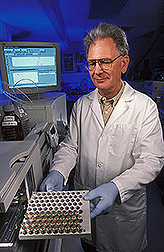This page has been archived and is being provided for reference purposes only. The page is no longer being updated, and therefore, links on the page may be invalid.
Read the magazine story to find out more. |
|
Walnuts' Secret Defense Explored
By Marcia WoodMarch 9, 2005
With their rich taste and pleasing crunchiness, it's no wonder that walnuts are one of America's favorite tree nuts. But walnuts, like several other kinds of crops, are vulnerable to attack by fungi called Aspergillus flavus and A. parasiticus. Both species can produce a natural compound called aflatoxin, which is thought to be carcinogenic.
Though inspections ensure that the walnuts that make their way from orchards to the home are free of harmful levels of aflatoxin, Agricultural Research Service scientists in Albany, Calif., want to do more to combat the fungi. For example, they've compared the A. flavus resistance of nearly a dozen leading kinds of English walnuts--the kind most widely marketed in the United States--and two species of black walnuts, which are less widely grown because their thicker shells are harder to open.
These laboratory experiments, led by ARS research chemist Russell J. Molyneux of the agency's Western Regional Research Center at Albany, showed that a popularly grown walnut known as Tulare was remarkably resistant to Aspergillus. Molyneux did the work with chemist Noreen E. Mahoney at the Albany laboratory and with University of California, Davis, collaborator Jim McKenna. Davis researchers Charles A. Leslie and Gale H. McGranahan also participated.
Tulare's secret defense? It's gallic acid, found only in the nutmeat's thin skin, or pellicle, according to Molyneux. Tulare walnuts contained one-and-one-half to two times more gallic acid than, for instance, Chico walnuts, the most Aspergillus-susceptible of the walnuts that the researchers tested.
Earlier, scientists elsewhere had shown that gallic acid has antimicrobial effects. But Molyneux's team is likely the first to show that a crop susceptible to an aflatoxin-producing Aspergillus can actually prevent the Aspergillus from producing aflatoxin.
The work, published in 2003, paved the way for current Albany studies to discover how gallic acid undermines Aspergillus.
Read more about the research in the March issue of Agricultural Research magazine.
ARS is the U.S. Department of Agriculture's chief scientific research agency.

